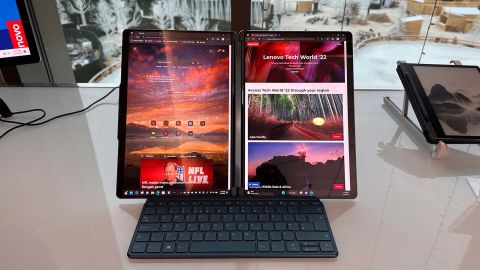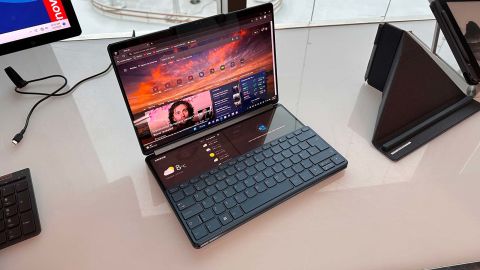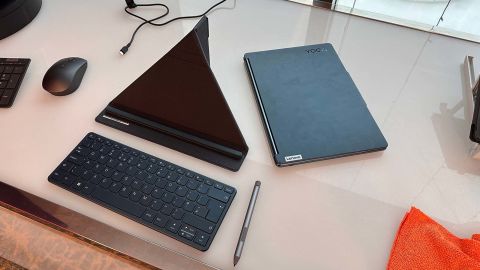CNN Underscored will be bringing you the best of CES 2023 all week. Be sure to check out our CES 2023 coverage hub for hands-on previews of the biggest tech this year straight from the show floor.
You can always count on seeing a handful of eye-catching, innovative and, frankly, excessive laptops at CES, and this year was no different. But while the two-screen Lenovo YogaBook 9i certainly falls into that showstopper category, it also has a host of promising features that could make it a practical consideration for folks serious about their multitasking.
With dual OLED displays that can be configured in a number of ways, not to mention an included stand, keyboard and pen, the YogaBook 9i is far and away one of the coolest gadgets I’ve gotten my hands on at CES 2023. But it is is it right for you? Let’s take a closer look.
Product: Lenovo YogaBook 9i
Launch date: June 2023
Price: From $2,100
Why it’s worth your attention: We’ve seen dual-screen laptops before, but few have been as sleek or practical as the YogaBook 9i. It’s expensive, but you’re essentially getting the benefits of a dual-monitor setup within a compact laptop you can take anywhere.

The YogaBook 9i is essentially an all-screen Windows laptop. Instead of a display on the top side and a keyboard deck on the bottom, you’re getting a 13.3-inch OLED display on both halves that you can use in all sorts of neat ways, either with or without the included accessories.
It’s hard not to be stopped in your tracks by a laptop that essentially stacks two displays on top of one another, which is just one of the many setups made possible by the YogaBook 9i’s included stand and detachable keyboard. This configuration allowed me to see twice as much content at once as I scrolled through the Underscored home page, and made it easy to multitask with a different app open on each screen. Flip the YogaBook 9i sideways on its stand, and you suddenly have two tall vertical displays — something that Lenovo said is ideal for consuming mobile video, and a setup that I’d personally use for having things like Google Docs and Slack open side by side .

What impressed me the most across these two modes was just how easy it was to stretch and move content. A quick five-finger swipe puts your app into “waterfall mode,” essentially stretching it across two displays. And if you need to move a window from one screen to another, you can do so with a quick flick of a finger (or use Windows’ handy on-screen multitasking prompts).
There’s just one drawback: The included keyboard doesn’t have a touchpad, so you’ll have to navigate via touch controls or bring your own Bluetooth mouse. I’d personally do the latter if I owned one of these, as having no way to mouse around the screen felt awkward in this otherwise neat setup.
Fortunately, the YogaBook 9i can also function like a traditional laptop. Prop it up in laptop mode by itself, and the notebook will automatically pull up an on-screen keyboard on the bottom half, complete with a virtual touchpad and haptic feedback that made the screen feel surprisingly good to type on.

And here’s the coolest part. You can flick the keyboard to the top or bottom of the secondary screen with a quick four-finger gesture. Move the keyboard up top, and you’ll have a full touchpad and virtual mouse buttons at the bottom. Slide it to the bottom, and you’ll have access to a variety of Windows 11 widgets for checking your Outlook inbox or viewing the weather with a quick glance. Best of all, you can plop the physical keyboard right on top of the bottom screen and enjoy the same functionality on either half. This was incredibly impressive to see in action, and for all of its wild gimmicks, I was happy to see the YogaBook 9i still functions well as a standard notebook.
In terms of guts, the YogaBook 9i features the latest Intel Core i7 processor, 16GB of RAM and 512GB of storage, which should be more than enough for most people’s workloads. It’s surprisingly compact at about 12 inches wide and 3 pounds, and its teal colorway stands out from the sea of silver and gray we often see on these types of notebooks.

Not everyone needs a dual-screen laptop, and $2,100 for any computer is a lot of money. But once you get past the shock of seeing two OLED displays stacked on top of one another, you’ll find what may be a compelling value for those who want the versatility of multiple displays combined with the portability of a laptop. You’re getting a pen, stand and keyboard out of the box, not to mention an entire other screen that you can use however you see fit.
The YogaBook 9i also seems like a more practical and affordable take on Lenovo’s own ThinkPad X1 Fold, which features a single foldable screen that we found wasn’t quite ready for primetime in our initial testing (not to mention the new model will start at $2,500 with no accessories). The YogaBook 9i is certainly one of the more compelling laptops we’ve seen in a while, and we look forward to fully putting it through its paces later this year.
.